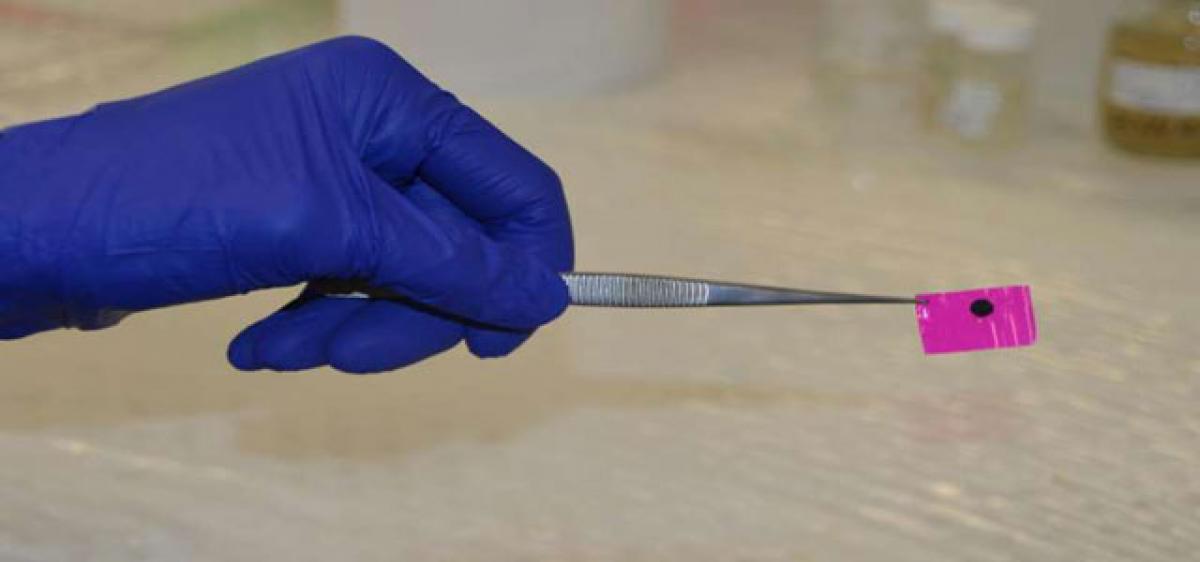Live
- Jani master controversy: Everything you need to know about it
- Poshan Maah Celebration in Medikonda: Empowering Mothers and Children
- Arbitrary Arrests Won't Sustain People's Governance: Revanth Reddy
- Arbitrary Arrests Won't Sustain People's Governance: Revanth Reddy
- Thalaivettiyaan Paalayam Review
- India Capitals appoint Ian Bell as captain for LLC season 3
- MP CM to visit Kolkata to attend Global Business Summit on Friday
- 49th All India Music & Dance Competitions Begin Today with Inaugural Ceremony
- Popular auctioneer Richard Madley to helm SA20 player auction on October 1, 2024
- President Murmu wins hearts in MP, seeks blessing of Mahakaal
Just In

Researchers have made a significant advance in heart attack research, with the development of a polymer patch, which improves conduction of electrical impulses across damaged heart tissue. The flexible patch, which has been shown to work in animal models, is long lasting and has the significant advantage that it can be stuck onto the heart without the need for stitches.The research, by an Austr
Researchers have made a significant advance in heart attack research, with the development of a polymer patch, which improves conduction of electrical impulses across damaged heart tissue.
The flexible patch, which has been shown to work in animal models, is long lasting and has the significant advantage that it can be stuck onto the heart without the need for stitches.
The research, by an Australian and British team led by Dr Damia Mawad at UNSW in Sydney and Professor Molly Stevens at Imperial College London, is published in the journal Science Advances
.
“Heart attacks create a scar which slows and disrupts the conduction of electrical impulses across the heart,” says study team member Professor Sian Harding of Imperial’s National Heart and Lung Institute.
“This leads to potentially fatal disturbances of the heart rhythm. Our electrically conducting polymer patch is designed to address this serious problem.”
The patch is made from three components: a film of chitosan, a polysaccharide found in crab shells that is often used as a food additive; polyaniline, a conducting polymer that is grown on top; and phytic acid, a substance found in plants which is added to the polyaniline to switch it to its conducting state.
“Conducting polymers work when they are dry, but most become non-conducting in a very short time when placed in bodily fluids,” says study first author Dr Mawad, of UNSW ‘s School of Materials Science and Engineering.
“Our suture-less patch represents a big advance. We have shown it is stable and retains it conductivity in physiological conditions for more than two weeks, compared with the usual one day of other designs.
“No stitches are required to attach it, so it is minimally invasive and less damaging to the heart, and it moves more closely with the heart’s motion.”
The patch is made to adhere to the heart tissue by shining a green laser on it, in a patented technique developed at UNSW by Dr Antonio Lauto of Western Sydney University.
Team members at the British Heart Foundation’s Imperial Cardiovascular Regenerative Medicine Centre, led by Professor Harding and Professor Cesare Terracciano, tested the patch by implanting it into rats. They found it improved the conduction of electrical impulses across the heart scar tissue.
Professor Molly Stevens says, “The patch can help us better understand how conductive materials interact with heart tissue and influence the electrical conduction in the heart, as well as better understand the physiological changes associated with heart attacks.”

© 2024 Hyderabad Media House Limited/The Hans India. All rights reserved. Powered by hocalwire.com







